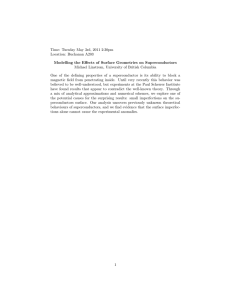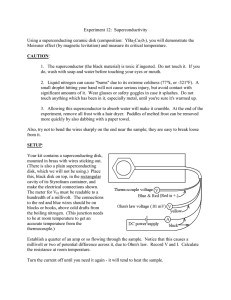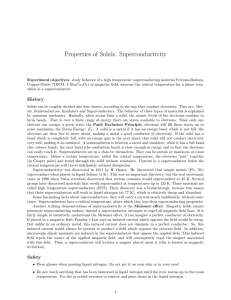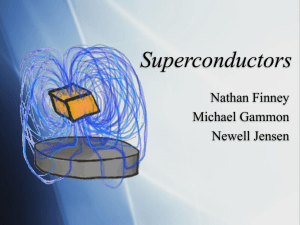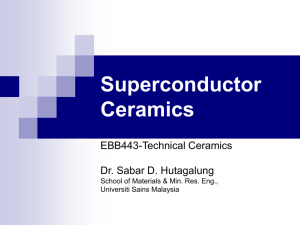5G50.50 Superconductors Meissner Effect
advertisement
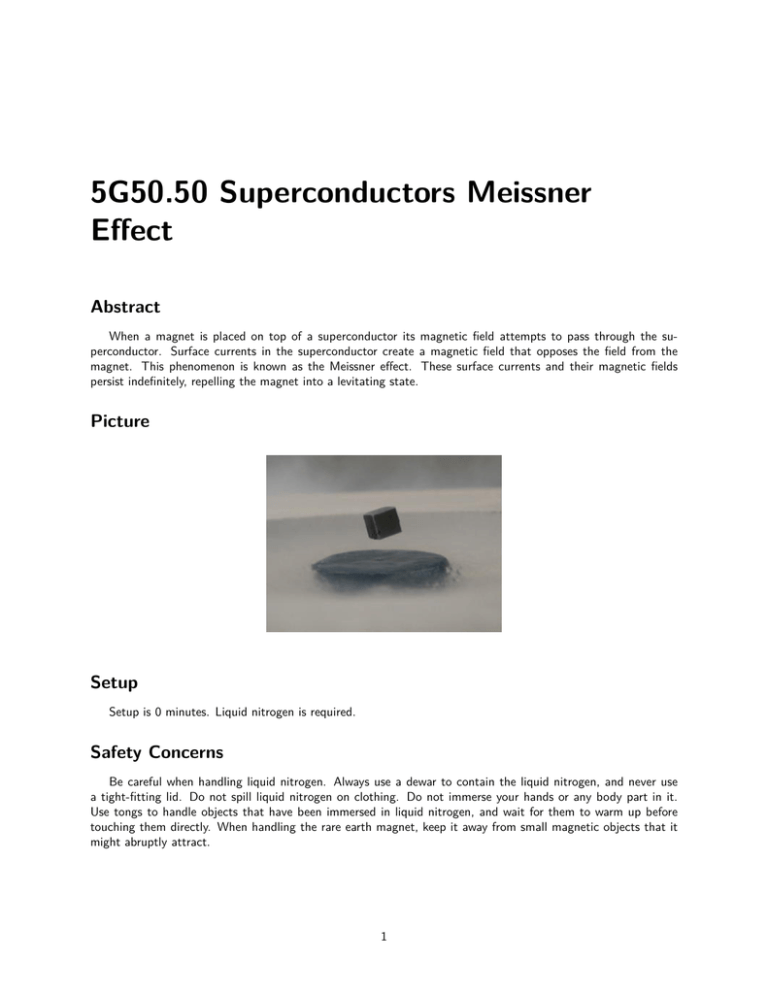
5G50.50 Superconductors Meissner Effect Abstract When a magnet is placed on top of a superconductor its magnetic field attempts to pass through the superconductor. Surface currents in the superconductor create a magnetic field that opposes the field from the magnet. This phenomenon is known as the Meissner effect. These surface currents and their magnetic fields persist indefinitely, repelling the magnet into a levitating state. Picture Setup Setup is 0 minutes. Liquid nitrogen is required. Safety Concerns Be careful when handling liquid nitrogen. Always use a dewar to contain the liquid nitrogen, and never use a tight-fitting lid. Do not spill liquid nitrogen on clothing. Do not immerse your hands or any body part in it. Use tongs to handle objects that have been immersed in liquid nitrogen, and wait for them to warm up before touching them directly. When handling the rare earth magnet, keep it away from small magnetic objects that it might abruptly attract. 1 Equipment • Superconductor Meissner Effect Kit • Styrofoam container and cup • Liquid Nitrogen Procedure Place the YBCO disk in the circular Styrofoam groove and pour liquid nitrogen into the groove until it just covers the entire superconductor. More liquid nitrogen may need to be added as it boils. The YBCO disk will have reached superconducting temperatures when the liquid nitrogen stops boiling. Using the plastic tongs, place the cubical magnet half a centimeter above the superconductor. When it is released, it will levitate above the superconductor. A light push with the tongs can set the magnet spinning with very little resistance. As the YBCO warms up, the magnet will slowly come to rest on the disk. The superconductor must be dried off while it warms to prevent moisture from being absorbed into the disk. Any remaining liquid nitrogen will eventually boil away, but it can also be gently spilled onto a laminated floor where it will evaporate faster. Place all contents back in the levitation kit when finished, and return all components to the demonstrations room. Theory An electrical conductor is an object through which electricity may flow. Although technically all materials permit current flow under certain conditions, in practice most objects are typified as either conductors (which permit current flow) or insulators (which prevent it). The factor that determines whether an object is a conductor or insulator is its resistance, which depends on both its geometry and the resistivity of its composite material. Resistivity, which varies from material to material, is a more general measure of opposition to current flow because it is independent of object geometry. In a given material, resistivity decreases as temperature decreases. In 1911, Heike Kamerlingh Onnes (1853-1926) discovered that certain metals exhibit zero resistivity at temperatures near liquid helium temperature (4.2 K). Metals that exhibit zero resistivity are called superconductors. It was found in 1986 that ceramics, from a class of materials called perovskites, exhibit superconductivity at much higher temperatures. These temperatures can sometimes reach as high as 90 K or even 140 K. These perovskite materials are classified as high-temperature superconductors, whereas those that require lower temperatures are appropriately known as low-temperature superconductors. The discovery of high-temperature superconductors was important because these temperatures are well above the boiling point of nitrogen (77 K). This meant that liquid nitrogen, which is both less expensive and easier to store than liquid helium, could be used to cool the perovskites sufficiently that they become superconductive. The temperature at which a material becomes a superconductor is known as its critical temperature, Tc , and there are several factors that affect a superconductor’s Tc . The critical temperature of a given superconductor is not only a function of its material composition, but rather it is unique to that particular superconductor. The critical temperature also depends on whether or not any current is flowing through the sample, and whether a magnetic field is present. For instance, a superconductor immersed in a magnetic field will have a lower critical temperature than one that is not. Finally, the critical temperature of a particular sample is also affected by whether or not the sample has many chemical impurities or structural defects. The high-temperature superconductor used in this demonstration is Y Ba2 Cu3 O7 (YBCO). An experimental plot of its resistance as a function of temperature is shown in Figure 1. The sharp decline in resistance seen in the graph is characteristic of all superconductors, and also provides an estimate for the critical temperature of the superconductor. For a YBCO superconductor operating with a current of 0.3 A, the critical temperature is between about 85 K and 88 K. For a given temperature of superconductor, there are also other ”critical” values. One is the critical current density, Jc , the maximum current density that can be applied through a superconductor before it loses its superconducting properties. It is important to never apply a current greater than Jc through a superconductor, because the loss of superconductivity is permanent. Just as the critical temperature of a superconductor depends on the applied current and magnetic field, so too the critical current density is dependent upon the temperature and magnetic field of a superconductor at any given point in time. 2 Figure 1: Graph of the experimental resistance of Y Ba2 Cu3 O7 plotted as a function of temperature. Finally, there is also a critical magnetic field strength, Bc , associated with a superconductor in a given state. The exact value of Bc depends on the temperature of, and current through, the superconductor. It also provides another means of classifying superconductors. In Type I superconductors there is only one value for Bc . Above this field, the sample becomes ”quenched” and loses its superconductive properties. Note that this loss of superconductivity is only temporary, and that superconductivity can be restored simply by removing the field. Type II superconductors are slightly more complex, and must be characterized by two critical magnetic field values, Bc1 and Bc2 . Below Bc1 , the superconductor behaves as a Type I superconductor, resisting all magnetic flux due to a phenomenon called the Meissner effect. Above Bc1 , but below Bc2 , the superconductor enters what is known as a mixed state where there exist some regions in the superconductor that allow the presence of flux. In the mixed state the superconductor retains its overall zero resistivity. Above Bc2 , the superconductor loses its superconducting properties just like with Type I superconductors. The Meissner effect is a phenomenon unique to superconductors whereby they oppose all magnetic flux. When a superconductor is in the presence of an external magnetic field surface currents are induced in the → − B N et External → − B N et External Superconductor Superconductor (a) Above Tc . (b) Below Tc . Figure 2: Diagrams of a superconductor above and below the critical temperature, Tc , within an external magnetic field. 3 superconductor that generate magnetic fields opposing the external field. The result is that the external magnetic field is cancelled in the superconductor. It is important to note that the Meissner effect is fundamentally different from Faraday’s law of induction. The law of induction describes the opposition in a conductor to a change in magnetic flux, while the Meissner effect is an opposition in a superconductor to any magnetic flux. Figures 2a and 2b shows the YBCO disk in a magnetic field for instances when the YBCO is above and below critical temperature. The magnetic field is free to enter the disk when it is above the critical temperature, but no field can penetrate the disk once it is cooled below its critical temperature. In this demonstration, a magnet is levitated above a superconductor through the Meissner effect, as seen Magnet in Figure 3. When the magnet is placed on top of the → − superconductor, its magnetic field attempts to pass B M agnet through the superconductor. As a result, surface cur→ − rents are set up in the superconductor and their magB Superconductor netic fields oppose that of the magnet, repelling the Surface magnet into a levitating state and preventing any magcurrent Superconductor netic flux from passing through the superconductor. As the superconductor cools, it gradually reverts to its Figure 3: Diagram showing the induced surface currents normal state and the magnet slowly comes to a rest on and magnetic field of the superconductor as well as a the superconductor. In the presence of the rare earth magnet used in the demonstration, the critical temlevitating magnet. perature of the YBCO superconductor lies within the 90 K - 100 K range. 4 References [1] Colorado Superconductors Inc., Experiment Guide for Superconductor Demonstrations, Version 7.0, May 2007. pg 6-7, 16-18. 5
